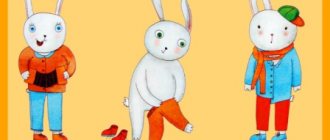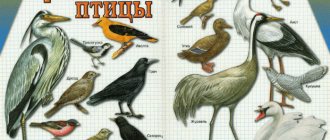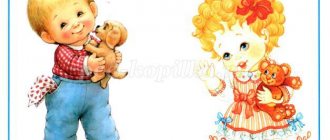Game exercises for children to differentiate sounds S-C
Differentiation of S-Ts sounds using game techniques
Goal: differentiation of S-Ts sounds. Objectives: 1. To develop in preschoolers correct sound pronunciation, the ability to differentiate the sounds C-C in their speech, and to use them correctly. 2. Using a didactic game, diversify the work on consolidating correct sound pronunciation and interest children. Description: It is known that didactic games are an effective means of speech therapy work with children. Dear colleagues, this time I offer you games from my collection for differentiating S-C sounds. These games contribute to the formation of correct sound pronunciation in a child’s speech, develop memory, attention, thinking, fine and gross motor skills. These games can be conducted by both a speech therapist and a teacher. This work will be useful to speech therapists, speech therapists, educators, and parents. Contents of “Guess” Depending on what sound in the word you need to show the corresponding letter.
- Sleigh, chicken, well, mask, boot, heron, figure, wasp, little finger, king, elephant, trailer, soup, sprinkle, sheep, top hat, street, fox, sail, rings, face.
Finger game “Fingers-Rings” The task is aimed at differentiating the pronunciation of sounds S-C in syllables and words;
on the development of phonemic perception and auditory memory; for the development of fine motor skills Come on, fingers,
In the rhythm of each line, we clench our fingers into a fist.
Come out in a row!
We will bend our fingers into rings, in the rhythm of each word we make rings when the thumbs touch the index, middle, ring and little fingers of both hands.
Fingers will help
In the rhythm of each line, we clench our fingers into a fist
Name the words and syllables!
In the rhythm of each word, we make rings when the thumbs touch the index, middle, ring and little fingers of both hands.
SA-CA-SA
In the rhythm of each line, we connect the thumb into a ring with the index, middle, and ring fingers of the right hand.
CHEESE-CHICKEN-AND SCALES,
Do the same with the fingers of the left hand.
TZI-SY-TZ
In the rhythm of each line, we connect the thumb into a ring with the index, middle, and ring fingers of the right hand.
CIRCUS-SON-AND CUCUMBERS
We do the same with the fingers of the left hand.
SO-TSO-SO
In the rhythm of each line, we connect the thumb into a ring with the index, middle, and ring fingers of the right hand.
PACIFIC-BASE-AND-RING
We do the same with the fingers of the left hand.
TSO-SO-TSO
In the rhythm of each line, we connect the thumb into a ring with the index, middle, and ring fingers of the right hand.
CASE-SOBLE-LETTER
We do the same with the fingers of the left hand. Speech motor game “Family” with elements of psycho-gymnastics The game is aimed at differentiating the sounds S-C in poetic speech; on the development of the child’s emotional sphere./i] Mom smiles, We put a smile on her face. Daddy swears, We shake our index finger. Little brother is having fun, making a playful face. My sister can’t sit still, so we pretend to be “fidgety.” Grandfather and grandmother are angry, we make an angry face. Children fidget a lot. We turn our heads. Well, I’m the most obedient one. Let’s point to ourselves. I'm not angry. We make a negative gesture with our finger. Neither mom and dad, We make a negative gesture with our finger and head. Neither grandpa nor grandma. Give everyone a kiss, sonny! We poke ourselves in the cheeks with our index finger.
We recommend watching:
Didactic game for children 5 - 7 years old Speech therapy leisure in the preparatory group Winter tongue twisters and poems for automating and differentiating sounds Didactic game for preschoolers 4-7 years old
Similar articles:
Tongue twisters for practicing the sounds of the Russian language
Abstract of GCD Sound culture of speech: the sound “C”
Author:
Vorontsova Svetlana Pavlovna,
teacher
MKDOU kindergarten "Yolochka"
Bolchary village, Kondinsky district, Tyumen region.
Target
- exercise children in pronouncing the sound “ts” (isolated, in syllables, in words)
-improving intonation expressiveness of speech
-learn to distinguish words with the sound “ts”.
-development of phonemic hearing, creative imagination, fine motor skills of the fingers
Progress of the lesson.
Our friend Gnome came to visit us and asks him to teach him how to pronounce the sound “ts” correctly. We'll help.
The teacher suggests turning to magic mirrors and doing articulation gymnastics
Articulation gymnastics complex
"Smile"
Keep your lips stretched out in a smile. The teeth are closed and not visible.
"Chick"
Open your mouth wide, spreading the corners of your lips as far apart as possible. The tongue lies in the mouth calmly and motionless.
"Spatula"
Open your mouth. Place a wide, relaxed tongue on your lower lip. Place the “spatula” in your mouth, trying not to strain your tongue.
"Fence"
Smile (teeth closed and not visible). Keep lips in this position.
"Punish the naughty tongue"
Open your mouth slightly, calmly put your tongue on your lower lip and, spanking it with your lips, say “five-five-five...”.
"Tube"
Open your mouth, stick out your wide tongue and bend its side edges up. Blow into the “tube”. You can hold the “tube” from the tongue with your lips.
"Watch"
Stretch your lips into a smile. Open your mouth slightly. Using the tip of your narrow tongue, alternately touch the corners of your mouth.
Now listen to the riddle:
-Two ends, two rings,
And in the middle there are carnations.
The teacher praises the children and, slightly intoning the words, says: sun, scissors, heron, rings.
-.Which sound did I highlight? The sound “ts” is correct. You also need to learn how to pronounce it correctly and clearly. Our Dwarf is already asking to play with him. Join us.
The teacher asks you to briefly and loudly pronounce the sound “ts” (ts-ts-ts-ts) several times - lips in a smile, the tip of the tongue rests on the lower teeth.
-Remember which bird sings this song. Of course, the titmouse. Make beaks out of your fingers and let your tits talk to each other (children do the exercise).
Gymnastics for the eyes.
Let our magic titmouse “fly” and we will follow it with our eyes. Show the Gnome how we train our eyes
- The titmouse flew up, circled, circled and fell to the ground.
She walked right, left, and flew into the window.
She flew far away (they peer into the distance), and sat down on the window again.
Waving your eyelashes and seeing her off on her way.
The teacher suggests looking at pictures of animals and learning onomatopoeia.
Squirrel - tsik-tsik
Horse - tsk-tsk ok
Grandma calls the chickens - chick-chick
The cat catches the mouse - tsap-tsap.
The teacher invites the children to unite in a circle. Finger game “Fingers say hello”
With the simultaneous pronunciation of the syllables tsa, tso, tsu, tsy. First with the right hand, then with the left, then with both hands at the same time.
Game "Talkative Men"
Standing in a circle in pairs (turning to each other), pronounce combinations of syllables in different intonations after the teacher, accompanying with voluntary movements:
Sa-tsa; sy-tsy; so-so; se – tse; su-tsu
The teacher also suggests saying a simple phrase, accompanied by dance movements:
TsA-TsA-TsA - here comes the sheep.
TSU – TSU – TSU – I’ll feed the sheep.
Tsy -Tsy -Tsy - carrying hay for the sheep.
TSE-TSE-TSE - I will give hay to the sheep.
The children sit at the tables. The game "Labyrinth" is offered
(in the pictures, children see images of objects with the sound “ts”, they are asked to choose as many words as possible for the first picture, for example: “What a bird - a beautiful bird, a small bird ...
Move to the next picture in the direction of the arrow.
-table (bird – sun – egg – chicken, etc.)
Now look at the pictures on your tables and listen to the task:
“Name the objects drawn in the picture and circle those in which the sound “ts” is heard.
One child reads out the progress at the board; the rest of the children complete the task in their places.
Everyone did a great job and deserves a fun holiday.
Children sing and dance “Dance of the Worms” (disc
In the evening, children are offered coloring pages depicting a hare and a heron.
Parents receive homework: learn the riddle with their children:
«There is a palace on the pole, and a singer in the courtyard. Who is this starling?
Literature used to compile the summary:
-O. Novikovskaya – “100 exercises for speech development
-V. Gerbova – “Classes on speech development in the middle group of kindergarten”
-Workbook “Literacy lessons for kids” (School of the Seven Dwarfs)
-L. Komarova “Automation of the sound “C” in game exercises.
-E. Zheleznova - “LogoriKindergartens of the Tyumen Region” is an officially registered specialized media outlet at the federal level. 2. The activities of the editorial office are supported by the Department of Education and Science of the Tyumen Region 3. We issue a “Certificate of Publication” in the media. 4. The document has a unique number, is entered in the register, has the original seal of the editorial office of the online publication and signature. 5. “Certificate of publication” in the media is sent to the author in both paper and electronic versions.
Details >>>
Sample “Certificate of publication of author’s methodological material in the media.”pdf
Share






